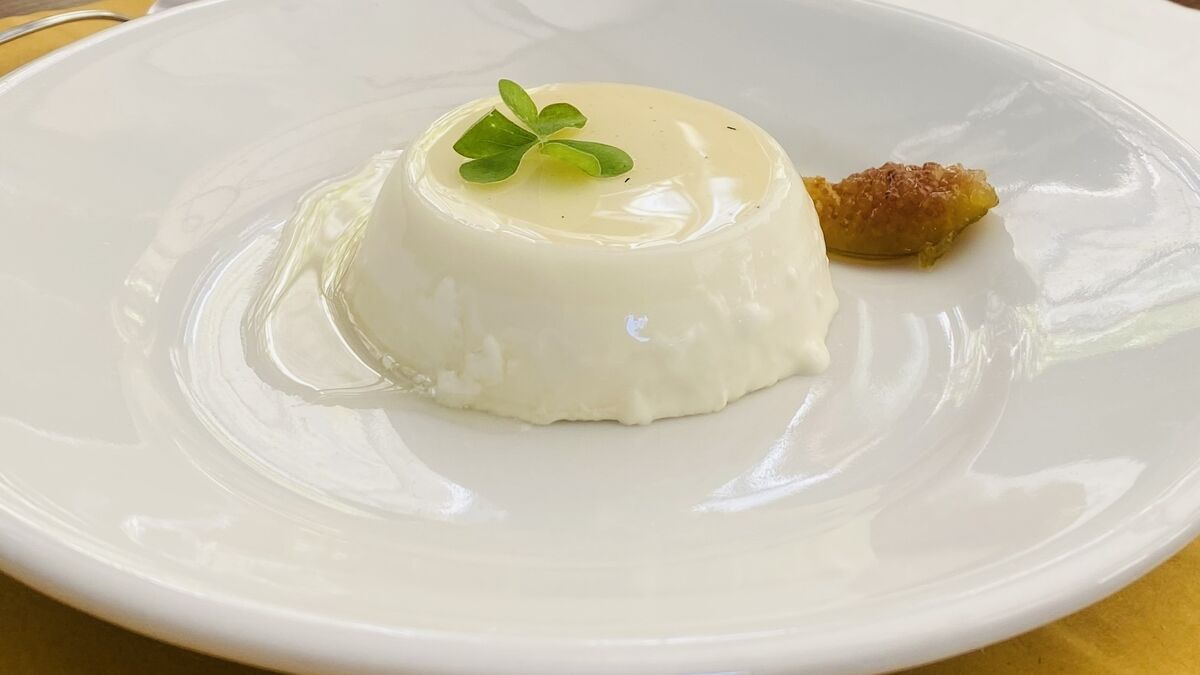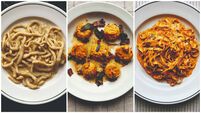Darina Allen: These Tuscan recipes are a reminder of the fragility of our ecosystems

Some of Darina Allen's Tuscany finds.
Trundling along on the train from Pisa to Siena, it was a joy to see so many lovely little vegetable gardens alongside the railway track.
Lots of globe artichoke plants, beans still clambering up wicker teepees, end-of-season sweetcorn and tomatoes, a few grape vines and here and there a couple of olive trees.
The weather was beautiful, with clear blue skies, and the countryside was bathed in sunshine, nonetheless, everything looked sad and parched.
I was on my way to Tenuta di Spannocchia, a 2,000-acre organic estate in the midst of Maremma National Reserve in the province of Siena, to attend a Climate Farm School.
My fellow participants were all from the US, many were involved in policymaking for large corporations that are anxious to have a sustainable green image.
Others are advising philanthropists and private clients interested in investing in regenerative projects.
All were there to learn and understand more about farming systems, how ethically nutrient-dense food is produced and how we can best farm in harmony with nature to enhance the fertility of the soil, sequester carbon and produce healthy plants, animals and humans and absorb rainfall.
Except there was no water… It’s been months since there’s been a drop of rain, consequently, there were no olives and it’s a terrible year for viticulture. At a rough guess, they will have about a quarter of the usual grape harvest.
Apparently, it’s been insanely hot throughout the summer and was still around 30°C in mid-October. Many forest fires also but fortunately not on the Spannocchia estate where there are hundreds of acres of forest.
During the week, many brilliant speakers spoke on a variety of related topics, soil, geology, permaculture, forest and woodland management, models of transformation, a climate action plan…
We visited another eco estate, Tenuta di Paganico which rears longhorn cattle and Cinta Senese pigs and has a farm shop and café where visitors can buy beef and heritage pork and taste the produce of the estate and local area.
We also visited an organic rice farm at Tenuta San Carlo in the heart of Maremma in southern Tuscany owned and managed by Ariana, the fourth generation to steward this estate with a deep commitment “to create a better future for our children, our community and our planet”.
Everywhere we heard of the myriad of challenges facing farmers in every area at present, not least the fear and uncertainty caused by the unpredictability of climate change, coupled with the poor price for their produce at farm gate.
Early one morning at Spannocchia, Danielle took us foraging in the herb garden to collect some weeds, herbs and wild plants to incorporate into our cooking class. I am intrigued by food in the wild and always eager to learn more.
Some plants were familiar to me, many others were exciting new discoveries.
We picked the leaves of sow thistle (Sonchus oleraceus) and common poppy to add to the spinach and Swiss chard to incorporate into the filling for homemade ravioli. Apparently, pigs love sow thistle hence the name. They have yellow flowers and look a bit like tall dandelions. The red poppy flower petals went into the salad.
I love the honey/pea flavour of the young bladder campion leaves (silene vulgaris) They too went into the salad, together with the narrow, pointed leaves and white flowers of stitchwort (Stellaria holostea), also called the star of Bethlehem.
I also discovered that the shoots and roots of Hawksbeard (Crepis) are also edible and very good in the salad.
It’s also worth remembering that what we call weeds today, were our ancestors’ medicine cabinet and many contribute a myriad of health benefits. Wild plants haven’t been tampered with to increase yield, so still have the full complement of vitamins, minerals, trace elements and bioactive compounds like polyphenols not easily found in today’s processed foods.
We’ve crystallised violet flowers for years, but I hadn’t realised that the leaves are also edible and delicious. So, they too can go into a green salad from now on.
Back into the kitchen, where Laura and Daniella gave us a cooking class. We all made pasta together, chopped fresh herbs, stuffed the ravioli and watched as Laura butterflied a loin of pork and slathered it with freshly chopped rosemary, sage, and lots of fennel leaves, flowers and seeds.
We made a delicious fig leaf panna cotta for dessert and a wonderfully diverse foragers salad to accompany the roast pork.
Here are some of those recipes, which I hope you’ll enjoy making at home.
Pork Loin with Sage, Rosemary & Fennel (Arista al Finocchietto)
At Spannocchia they included fennel at three stages – leaves, flowers and seeds. The arista pork is also very tasty served the following day at room temperature the following day with homemade aioli or fennel mayonnaise.

Preparation Time
51 minsCooking Time
1 hours 15 minsTotal Time
2 hours 6 minsCourse
MainIngredients
1kg pork loin or neck/cappacuolo
5-6 sage leaves
1 sprig rosemary
fennel leaves and flowers if available
flaky sea salt and freshly ground black pepper
fennel seeds
4 tbsp extra virgin olive oil
Method
Preheat the oven to 220°C/Gas Mark 7.
Finely chop the sage leaves, rosemary, fennel leaves and flowers together.
Butterfly the pork with a sharp knife to open it out to twice the length.
Season the pork loin with flaky sea salt and freshly ground black pepper; sprinkle the chopped herbs and the fennel seeds evenly over the pork. Roll up and tie firmly. Then drizzle well with extra virgin olive oil.
Place the loin roll on a baking tray and pop into the preheated oven for 20 minutes, reduce the heat to 180°C/Gas Mark 4 and continue to cook for 55 minutes approx. until the internal temperature reaches 72°C.
When the pork is cooked, remove from the oven and allow it to rest. Skim the juices from the tray and spoon over the pork.
When ready to serve, remove the pork from the tray and slice (not too thinly!). Garnish with sprigs of rosemary and fennel.
Salad of Foraged Greens
Note: Italian lemons are much sweeter and juicier than the imported fruit we have access to so it may be necessary to add sugar to the dressing.

Cooking Time
10 minsTotal Time
10 minsCourse
SideIngredients
For the mixed salad, the following plants work well together:
stitchwort, pennywort, lemon balm, wild fennel, salad burnet, bittercress, common sorrel, purslane, plantain, nepeta, cowslip leaves and flowers, evergreen clematis (Clematis vitalba), nasturtium leaves and flowers, chive flowers, chicory leaves and flowers, leaves and flowers of purple mallow, violet leaves and flowers, marigold and daisy petals, wild thyme leaves, dandelion leaves and petals, bladder campion leaves and flowers, sage flowers, rosemary flowers, borage flowers, zucchini blossoms, rose petals, common poppy leaves and flowers….
Plants used for the salad should be young and fresh.
Italian Dressing:
1 tbsp fresh lemon juice or Balsamic vinegar
3 tbsp extra virgin Tuscan olive oil
sea salt and freshly cracked pepper
sugar to taste, use only with lemon juice
Method
Wash and dry the salad leaves, combine the ingredients for the dressing. Just before serving, toss the salad with the dressing and serve immediately.
Fig Leaf Panna Cotta
Serve with candied figs or a compote of fruit.

Servings
10Preparation Time
4 hours 30 minsTotal Time
4 hours 30 minsCourse
DessertIngredients
1 litre light cream (half milk/half cream)
4 tbsp sugar
5-6 fresh fig leaves, grilled over a gas flame for 1-2 minutes
3 sheets of gelatine
1 egg yolk
4 tbsp of milk
Method
Put the cream, sugar and fig leaves into a saucepan over a low heat, stirring often until the liquid comes almost to boiling point. Remove from the heat.
Put the sheets of gelatine into a bowl and cover with cold water. Allow to sit for a few minutes to soften.
Remove the gelatine sheets from the water (discard the water). Squeeze out the excess water. Add the softened gelatine sheets to the fig flavoured cream and sugar, stir for a few minutes until dissolved.
In a separate bowl, whisk the egg with the milk. Whisk in the fig flavoured cream and sugar mixture. Stir very well.
Pour the mixture into individual bowls and leave to cool in the fridge for at least 3-4 hours or until set.
Serve on fresh fig leaves with candied figs.
Excitement is building, don’t miss the Ballymaloe Craft Fair which runs over two weekends (17-19th and 24th – 26th November 2023) with over 180 different exhibitors each weekend including food and entertainment.
- For more information, see www.ballymaloegrainstore.com
Join us for an afternoon of our favourite comforting dishes including a focaccia-style soda bread and how about a winter root vegetable soup with a drizzle of kale pesto to add a sparkle to the bowl.
It’ll be a scorched Jerusalem artichoke salad with roast hazelnuts, buttery avocado and rocket leaves. Followed by a delicious Italian beef stew or a chunky vegetarian squash, bean and winter herb pot and we’ll finish off with a couple of comforting puddings — one rich and chocolaty, the other citrusy and also super delicious.
- An action-packed afternoon and a taste of every dish. cookingisfun.ie
Really looking forward to attending this long-established Food Fair with so many highlights – see you there....
- For more information, see www.listowelfoodfair.ie








